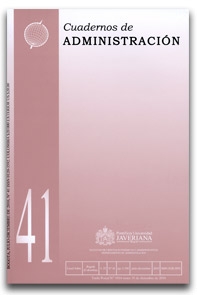Resumen
El propósito del artículo es responder si es posible implementar modelos de
medición avanzada para cuantificar riesgo operativo en instituciones financieras
en Colombia. Así, se comparan dos modelos desde el enfoque de distribución
de pérdidas agregadas, por medio de simulaciones de Montecarlo. Este enfoque
se basa en la teoría de riesgos de seguros para obtener la distribución de
pérdidas y estimar el valor en riesgo al 99,9% en un período de un año. El primer
modelo, propuesto por Böcker y Klüppelberg, se obtiene con una fórmula
cerrada cuando las pérdidas se ajustan a una distribución subexponencial. El
otro modelo está basado en la teoría del valor extremo. Al aplicarlo a las pérdidas
por riesgo operativo del 2008 de las entidades financieras colombianas, se
encuentra que la máxima pérdida esperada en el 99,9% de los mejores casos
es de 3,2 mil millones de pesos, considerado “razonable” según los activos.
Allen, L. and Bali T. G. (2004). Cyclicality in catastrophic and operational risk measurements. Unpublished paper. New York: City University of New York.
Balkema, G. and Embrechts P. (2007). High risk scenarios and extremes: A geometric approach. s. l.: Zürich Lectures in Advanced Mathematics-European Mathematical Society.
Beirlant, J.; Goegebeur, Y.; Segers, J. and Teugels, J. (2004). Statistics of extremes: theory and applications. New York: John Wiley & Sons.
Beirlant, J.; Dierckx G.; Goegebeur, Y. and Matthys, G. (1999). Tail index estimation and an exponential regression model. Extremes, 2, 177-200.
Böcker, K. and Klüppelberg, C. (2005). Operational VaR: a closed-form approximation. RISK Magazine, December, 90-93.
Multivariate models for operational risk. (2006). Munich: Munich University of Technology.
De Fontnouvelle, P.; DeJesus-Rueff, J. and Rosengren, E. (2006). Capital and risk: New evidence on implications of large operational losses. Journal of Money, Credit and Banking, 38, 1819-1846.
De Fontonouvelle, P.; Rosengren, E. and Jordan, J. (2004). Implications of alternative operational risk modelling techniques. Unpublished paper. Boston: Federal Reserve Bank.
Degen, M.; Embrechts, P. and Lambrigger, D. (2007). The quantitative modeling of operational risk: between g-and-h and EVT. ASTIN Bulletin, 37, 265-291.
Dutta, K. and Perry, J. (2006). A tale of tails: An empirical analysis of loss distribution models for estimating operational risk capital. Working Paper No. 06-13. Boston: Federal Reserve Bank.
Embrechts, P. (2009). Linear correlation and EVT: properties and caveats. Journal of Financial Econometrics, 7 (1), 30-39.
Klüppelberg, C. and Mikosch, T. (1997). Modelling extremal events for insurance and finance. Berlin: Springer.
Evans, J. R. and Olson, D. L. (2002). Introduction to Simulation and Risk Analysis (2nd ed.). New Jersey: Prentice Hall.
Huisman, R.; Koedijk, K.; Kool, C. and Palm, F. (2001). Tail-index estimates in small samples. Journal of Business and Economic Statistics, 19, 208-216.
Jobst, A. (2007). The treatment of operational risk under the New Basel framework: Critical issues. Journal of Banking Regulation, 8 (4), 316-352.
Kraujalis, S.; Karpaviciene, E. and Aurelijus, C. (2006). The specifics of operational risk assessment methodology recommended by Basel II. Engineering Economics, 3 (48). Recuperado el 25 de noviembre de 2010, de http://www.ktu.lt/lt/mokslas/zurnalai/inzeko/48/1392-2758-2006-3-48-07.pdf
McNeil, A. J.; Frey, R. and Embrechts, P. (2005). Quantitative risk management: concepts, techniques and tools. Princeton: Princeton University Press.
Mikosch, T. (2004). Non-life insurance mathematics: an introduction with stochastic processes. Berlin: Springer Verlag.
Moosa, I. (2007). Operational risk: a survey. Financial Markets, Institutions & Instruments, 16 (4), 167-200.
Mora, A. (2009). Un estudio comparativo de algunos estimadores del índice de valor extremo. Bogotá: Colegio de Estudios Superiores de Administración (CESA).
Moscadelli, M. (2004). The modelling of operational risk: Experience with the analyisis of the data collected by the Basel Committee. Banca d'Italia, Temi di discussione del Servizio Studi, 517, July.
Neslehová, J.; Chávez-Demoulin, V. and Embrechts, P. (2006). Infinite-mean models and the LDA for operational risk. Journal of Operational Risk, 1 (1), 3-25.
Reiss, R.-D. and Thomas, M. (1997). Statistical analysis of extreme values. Basel: Brikhäuser.
Wei, R. (2006). Quantification of operational losses using firm-specific information and external databases. Journal of Operational Risk, 1 (4), 3-34.
Cuadernos de Administración se encuentra registrada bajo la licencia Creative Commons Reconocimiento 4.0 Internacional. Por lo tanto, esta obra se puede reproducir, distribuir y comunicar públicamente en formato digital, siempre que se reconozca el nombre de los autores y a la Pontificia Universidad Javeriana. Se permite citar, adaptar, transformar, autoarchivar, republicar y crear a partir del material, para cualquier finalidad (incluso comercial), siempre que se reconozca adecuadamente la autoría, se proporcione un enlace a la obra original y se indique si se han realizado cambios. La Pontificia Universidad Javeriana no retiene los derechos sobre las obras publicadas y los contenidos son responsabilidad exclusiva de los autores, quienes conservan sus derechos morales, intelectuales, de privacidad y publicidad.
El aval sobre la intervención de la obra (revisión, corrección de estilo, traducción, diagramación) y su posterior divulgación se otorga mediante una licencia de uso y no a través de una cesión de derechos, lo que representa que la revista y la Pontificia Universidad Javeriana se eximen de cualquier responsabilidad que se pueda derivar de una mala práctica ética por parte de los autores. En consecuencia de la protección brindada por la licencia de uso, la revista no se encuentra en la obligación de publicar retractaciones o modificar la información ya publicada, a no ser que la errata surja del proceso de gestión editorial. La publicación de contenidos en esta revista no representa regalías para los contribuyentes.


